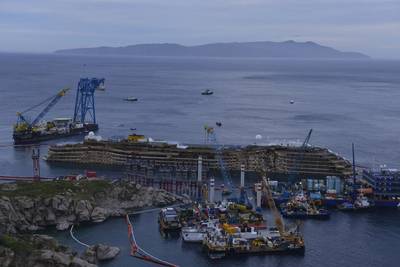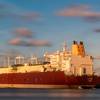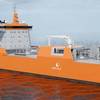OTS, DSM Congratulate Costa Crociere, Titan Micoperi
DSM, producer of ultra high molecular weight polyethylene (UHMwPE), branded as Dyneema, and OTS (Offshore & Trawl Supply AS), a Norwegian manufacturer of synthetic fiber ropes of extreme strength, are proud to congratulate Titan Salvage and Micoperi for their outstanding achievement in the Parbuckling project.
Dextron 12 Plus ropes made with Dyneema fiber took the strain of the Costa Concordia, holding it in position and relieving some of the tension felt by the engineers from Titan Salvage and Micoperi during this historic marine exercise.
Up ending the wreck, known as ‘parbuckling’, has been the most critical stage of a marine salvage operation, like no other in history, involving the best international expertise and advanced technologies. Before this extremely difficult and critical operation could be executed, the wreck had to be held in position to prevent the Costa Concordia from sliding off the reef, and subsea cliff, into deeper waters. In order to protect the immediate marine environment, the salvage team was confronted with a unique and extremely complex engineering operation.
Dextron 12 Plus ropes made with Dyneema fiber, manufactured by OTS AS in Norway, were selected by the salvage team. OTS`s patented Protective Jacket, a technology developed by OTS, was fitted on the ropes to protect the load bearing structure against abrasion. Lines made with Dyneema have a proven track record in maritime and offshore operations, including salvage lines. The combination of high strength with low weight enabled safer and easier handling compared to steelwire and chain. Synthetic fiber ropes are more frequently used in salvage operations in order to protect the immediate environment. Prior to the lines being commissioned, several load cases were carefully evaluated in order to estimate the behavior of the load bearing core during the salvage operation.
OTS and DSM have been supporting Captain Nicholas Sloane, Senior Salvage Master on the Costa Concordia Removal Project, throughout this project. According to him, the enabling technology, most of which is taking place under water, saved many days in installing the subsea hold-back system, minimizing the physical efforts required by the dive team. It also prevented elasticity and maintained the required strength while helping preserve the precious marine environment at the same time.
The Dextron 12 Plus ropes with Dyneema will remain connected to Costa Concordia throughout the winter, through to April/May 2014. They will hold the righted vessel in position while the sponsons (steel tanks, similar to those on the port side) are attached to the starboard side of the ship, after which refloating will begin prior to towing to its final destination.











